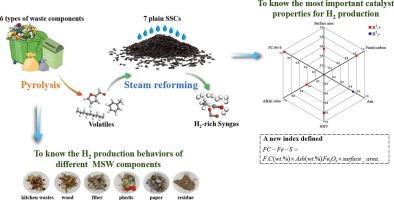污泥炭催化城市生活垃圾热解挥发物蒸汽重整生产富h2合成气:炭性质的影响
IF 7.1
2区 环境科学与生态学
Q1 ENGINEERING, ENVIRONMENTAL
引用次数: 0
摘要
本研究采用热解-蒸汽重整反应体系,以污泥炭为催化剂,以城市生活垃圾为原料制备富h2合成气。为了确定影响H2产率的最重要的SSC性质,比较了7种不同的SSC的催化性能,选择了合适的SSC作为催化剂。分别在550°C和800°C的温度下进行了城市生活垃圾的热解和挥发分的蒸汽重整,并对不同组分的H2产率进行了考察。研究发现,影响SSCs H2产率的最重要因素是固定碳(FC)含量,其次是铁含量和比表面积。用FC-Fe-S指数将SSC的性质与H2产率进行了相关性分析,两者呈正相关(R2 = 0.96)。此外,研究发现,城市生活垃圾中的塑料在热解过程中产生的长链脂肪族挥发性化合物最多,重整阶段的H2产率最高,为1.54 Nm3/kgwaste;而生物质组分由于氧含量较高,H2产率较低,在0.71 ~ 0.84 Nm3/kg废物之间。本研究为选择廉价的SSCs作为牺牲催化剂,通过城市生活垃圾热解-蒸汽重整技术提高H2产率提供了有价值的见解。本文章由计算机程序翻译,如有差异,请以英文原文为准。

Sewage sludge char catalyzed steam reforming of volatiles from MSW pyrolysis for H2-rich syngas production: Influence of char properties
This study employed a pyrolysis-steam reforming reaction system to produce H2-rich syngas from municipal solid waste (MSW) with sewage sludge chars (SSCs) as catalysts. To determine the most important SSC properties influencing H2 yield, catalytic performances of 7 different plain SSCs were compared to choose the proper SSC as catalyst. The pyrolysis of MSW and steam reforming of the volatiles were carried out at 550 and 800 °C respectively, and H2 production from different MSW components were also checked. It has been found that the fixed carbon (FC) content of SSCs is the most important factor influencing H2 yield, followed by Fe content and specific area. An FC-Fe-S index was defined to correlate SSC properties with H2 yield, which exhibits a strong positive correlation (R2 = 0.96). Additionally, it has been found the plastics in MSW produce the most long-chain aliphatic volatile compounds during pyrolysis process and result in the highest H2 yield of 1.54 Nm3/kgwaste in the reforming stage; while biomass components correspond to lower H2 yields ranging from 0.71 to 0.84 Nm3/kgwaste due to their higher oxygen contents. This research provides valuable insights for choosing cheap SSCs as sacrificial catalyst to enhance H2 production through MSW pyrolysis-steam reforming technology.
求助全文
通过发布文献求助,成功后即可免费获取论文全文。
去求助
来源期刊

Waste management
环境科学-工程:环境
CiteScore
15.60
自引率
6.20%
发文量
492
审稿时长
39 days
期刊介绍:
Waste Management is devoted to the presentation and discussion of information on solid wastes,it covers the entire lifecycle of solid. wastes.
Scope:
Addresses solid wastes in both industrialized and economically developing countries
Covers various types of solid wastes, including:
Municipal (e.g., residential, institutional, commercial, light industrial)
Agricultural
Special (e.g., C and D, healthcare, household hazardous wastes, sewage sludge)
 求助内容:
求助内容: 应助结果提醒方式:
应助结果提醒方式:


